The Thermaltake Toughpower GF A3 750W PSU Review: Mid-Range 750W PSU With 12VHPWR
by E. Fylladitakis on October 23, 2023 10:00 AM EST
Thermaltake is a company based in Taiwan that specializes in designing and manufacturing computer hardware components and accessories. Established in 1999, the company's product range includes thermal solutions such as CPU coolers and cases and power supply units, keyboards, and mice. Thermaltake operates globally and has a presence in multiple markets, serving a customer base that ranges from casual computer users to hardware enthusiasts. The company's products are subject to various industry certifications and standards.
Known for its diverse portfolio, ranging from cases and coolers to power supply units (PSUs), the company has a reputation for merging aesthetics with functionality. Among the lineup of their power supplies, the Toughpower GF A3 750W PSU stands as a prominent offering aimed at enthusiasts who demand a balanced mix of reliability, performance, and energy efficiency.
As PSUs are the backbone of any computing system, providing stable and efficient power is paramount. Thermaltake's Toughpower GF A3 750W PSU aims to do just that while adding modularity and aesthetic appeal into the mix. It is designed to target the bulk of advanced PC builders, which means it will also have to compete against myriads of similar products for a piece of that saturated market pie. In this review, we will dissect this power supply's features, performance, and overall value proposition to determine whether it meets modern PC builds' demands.
| Thermaltake Toughpower GF A3 Power specifications ( Rated @ 45 °C ) |
|||||
| RAIL | +3.3V | +5V | +12V | +5Vsb | -12V |
| MAX OUTPUT | 20A | 20A | 62.5A | 3A | 0.3A |
| 100W | 750W | 15W | 3.6W | ||
| TOTAL | 750 W | ||||
| AC INPUT | 100 - 240 VAC, 50 - 60 Hz | ||||
| MSRP | $98 - Currently $91 at Amazon | ||||
Packaging and Bundle
The Thermaltake GF A3 750W PSU arrived encased in a cardboard box of substantial thickness with a minimalist yet elegant external aesthetic. The essential features of the power supply unit are presented clearly on the box's exterior. The unit is securely enveloped inside the box in high-density packaging foam, providing ample protection against potential transit damages.
The accessory bundle accompanying the Thermaltake Toughpower GF A3 750W is basic but functional, consisting solely of the indispensable AC power cable, mounting screws, and a modest assortment of cable ties. Given the market segment this unit targets, including cable ties is a practical touch rather than an added luxury.
As the Toughpower GF A3 750W is a fully modular unit, a bundle of cables is supplied in a separate bag. All the cables are black, and most are made of flat, ribbon-line wires, except the 12VHPWR cable that features the traditional nylon sleeving. Note that Thermaltake declares that the maximum wattage of the 12VHPWR connector is 300 Watts for this model.
| Thermaltake Toughpower GF A3 | ||
| Connector type | Hardwired | Modular |
| ATX 24 Pin | - | 1 |
| EPS 4+4 Pin | - | 2 |
| EPS 8 Pin | - | - |
| PCI-E 5.0 | - | 1 |
| PCI-E 8 Pin | - | 4 |
| SATA | - | 8 |
| Molex | - | 4 |
| Floppy | - | 1 |
The Thermaltake Toughpower GF A3 750W PSU
External Appearance
The external visage of the Thermaltake Toughpower GF A3 750W PSU is distinctly marked by its matte black finish, lending the unit a stealthy and professional appearance. The chassis features a dashed line pattern punched on all sides, adding a layer of aesthetic complexity. With a 140 mm depth, the chassis dimensions conform to the ATX design guidelines, ensuring compatibility with ATX-compliant cases.
Electrical specifications and certification details are displayed on a sticker on the chassis's top side. Decorative stickers embellish both sides of the chassis without overwhelming the design, maintaining the unit's sleek aesthetic. There is a zero-RPM fan switch at the rear of the unit, in addition to the standard power cable receptacle and on/off switch. The connectors for the modular cables are featured at the front of the chassis. These connectors take less than half of the surface area and are situated adjacent to a printed color-coded legend.
Internal Design
Thermaltake is using one of its own fans for the cooling needs of the Toughpower GF A3 750W PSU. The TT-1225 (or BDH12025S) fan is a 120 mm model with a fluid dynamic bearing engine. It has a maximum speed of 1500 RPM.
The OEM responsible for creating the Toughpower GF A3 750W PSU is Great Wall, the designs of which we frequently find inside mainstream and high-end units as of late. We have not encountered this particular platform before. Considering the 300-watt 12VHPWR rating, it would seem that Great Wall has specifically developed it to compete in the mid-range segment of the market while providing ATX 3.0 compliance.
The filtering stage of the Toughpower GF A3 750W PSU is fair, with four Y capacitors, two X capacitors, and two filtering inductors. Two input-rectifying bridges can be found with a small heatsink sandwiched between them. Two Rubycon 420V/390μF capacitors and a reasonably large filtering inductor are the passive components of the APFC circuitry. The active components of the APFC circuit, two MOSFETs and a booster diode, share the same heatsink as the primary stage switchers.
The two inversion transistors form a typical half-bridge LLC inversion topology. The two inversion transistors are WML28N65SF2 from WAYON, a manufacturer we have only recently encountered products from. Unfortunately, once again, there are no datasheets of these particular chips to be found online.
Six transistors generate the main 12V line after the secondary side of the transformer. The transistors are the 4NA1R4C-A from Jinlibo Electronics. DC-to-DC circuits generate the 3.3V and 5V lines, all of the parts of which are installed on the main board itself. This is atypical as the vast majority of the designs have the DC-to-DC circuits on a vertical daughterboard. Advanced Power Electronics Corp supplies the four main switchers (4024GEMT) that generate the 3.3V and 5V lines, with an ANPEC APW7164 controlling each. All secondary side capacitors, polymer and electrolytic alike, are supplied by CapXon, a highly reputable Taiwanese manufacturer.


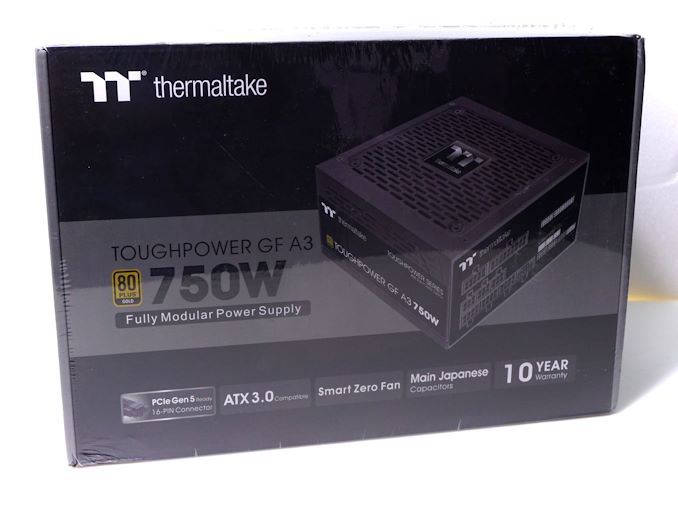
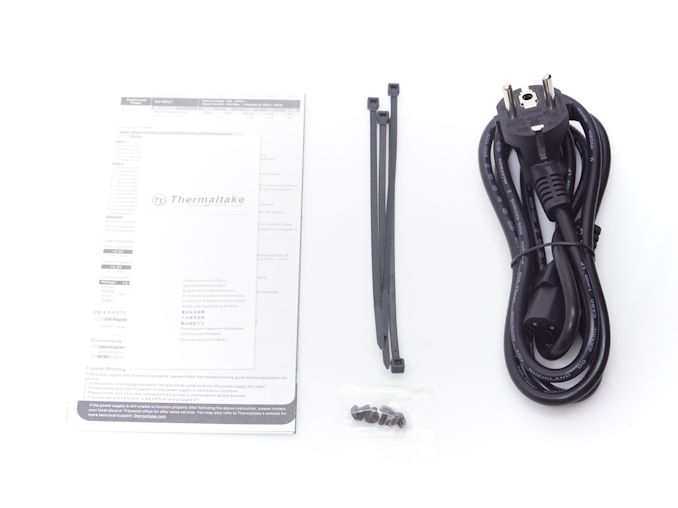
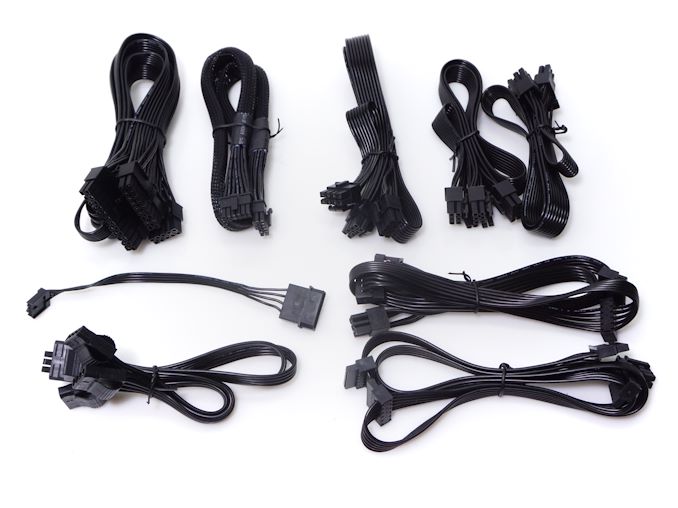
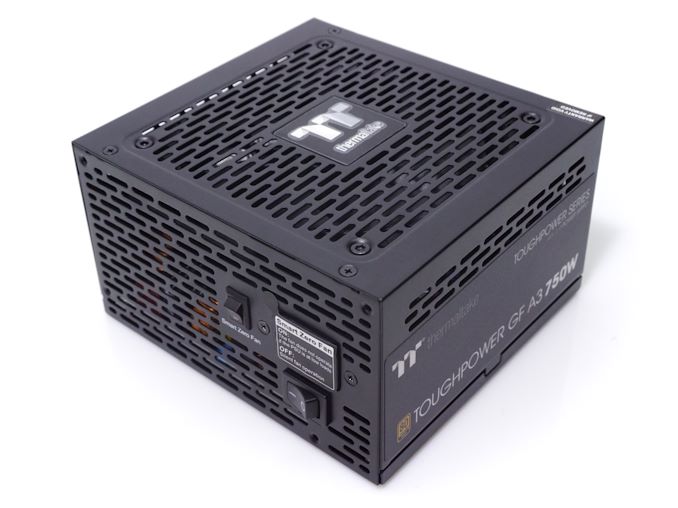
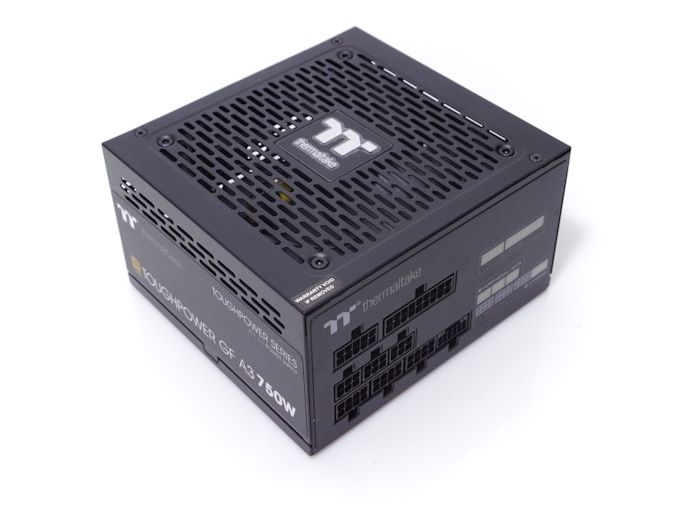
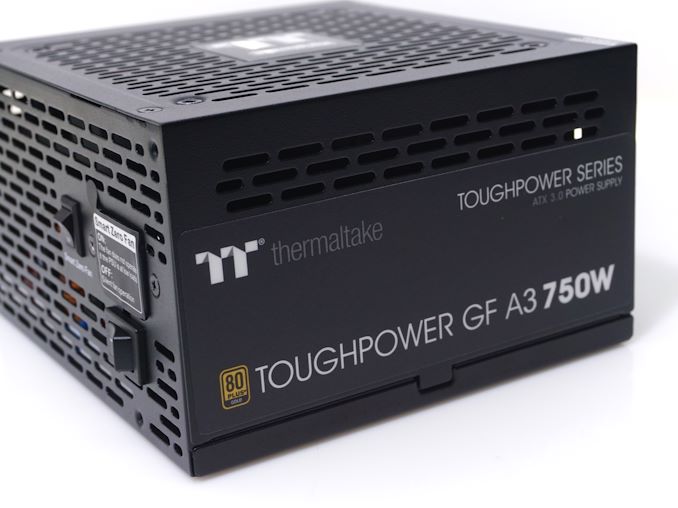
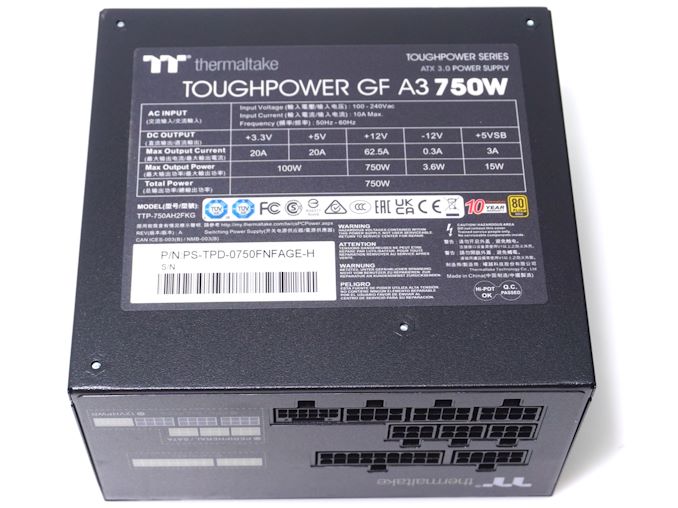

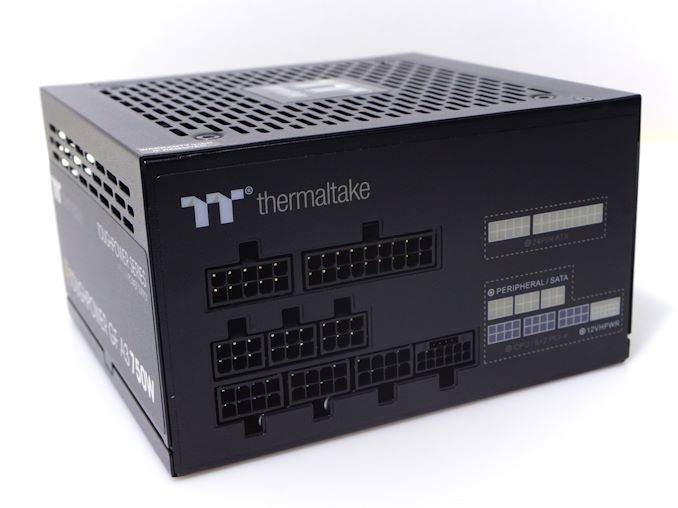

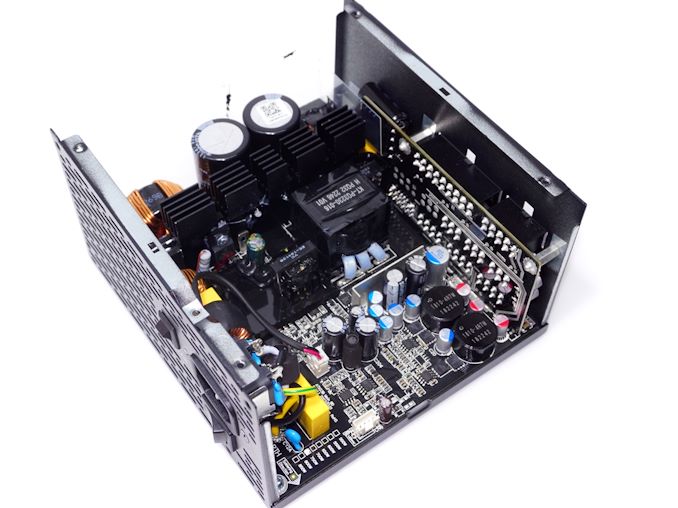
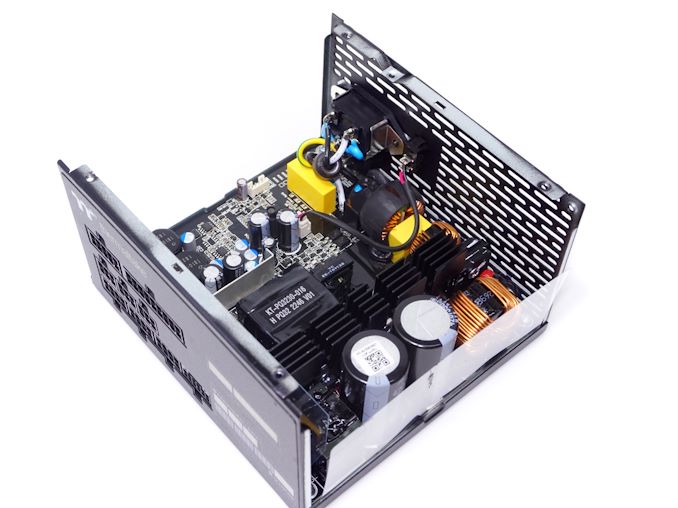
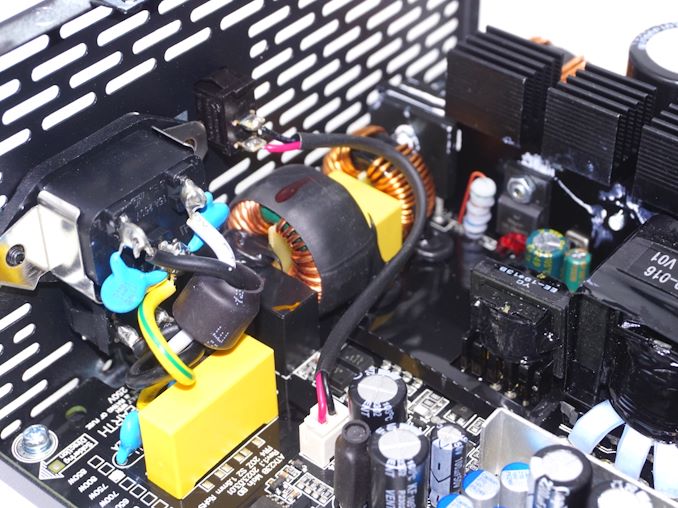
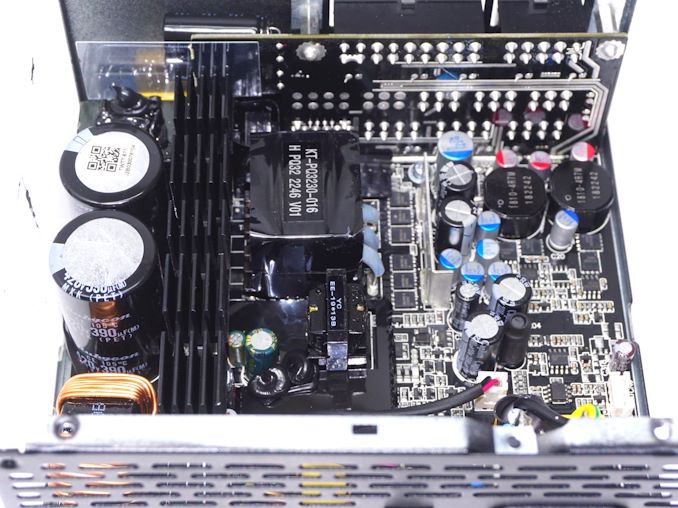
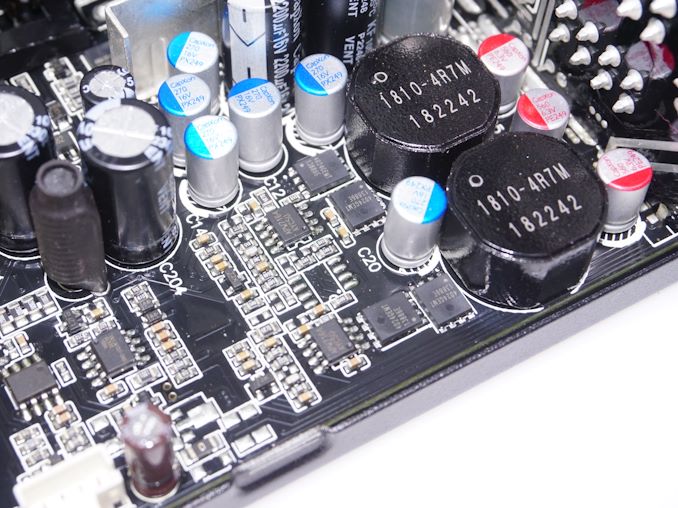
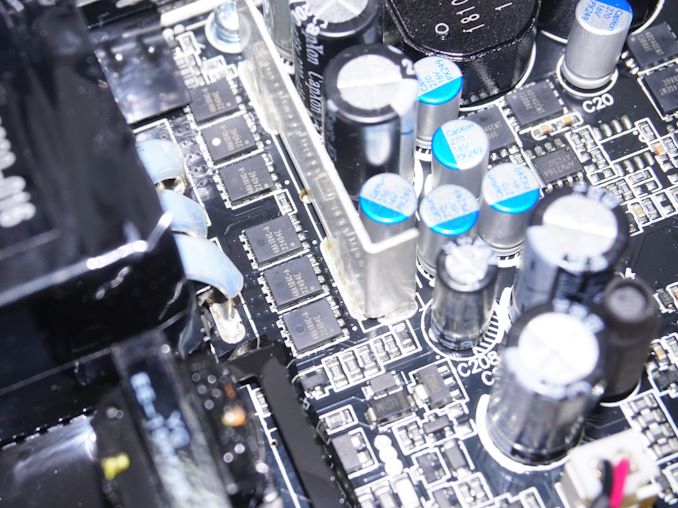








10 Comments
View All Comments
meacupla - Monday, October 23, 2023 - link
I find it interesting that TT doesn't use their toughfan in this. The 120mm version has good static pressure, which seems ideal for a PSU. Especially when it has a restrictive stamped finger guard.Samus - Monday, October 23, 2023 - link
Probably just money. I have been constantly let down by mid-range PSU fans and I get it, they need to cut corners somewhere, but the fan is arguable the most important part because its naturally, being mechanical, should be the only component that will eventually fail. And they constantly do.I recently replaced a 120mm fan in a Seasonic Focus. You would think anything Seasonic would be of exceptional quality but the fan started chattering, and at closer inspection the axial shaft in the motor disconnected from the fan housing and would be very difficult to repair (and not worth repairing for such a junk FDB fan)
Disturbingly these fans are used in their top-dollar Prime PSU's and upon research, people do have failures. While Seasonic has a 10 year warranty, even if you can provide proof of purchase and are willing to send it in and wait a week or two for RMA, is it worth it to get a PSU with the same crappy fan back when you can upgrade it to a superior fan for $10.
Obviously I chose to replace it with a better fan, which revealed another problem. The fan controller of the PSU is calibrated for the specific power draw of the fan, in my case it was 0.58A. I installed a Noctua 120mm fan that draws only 0.05A, and it runs at full speed all the time making more noise than any other component in my PC because the PSU is expecting a 0.58A fan. The Prime PSU's have a silence button that doesn't run the PSU fan until it's needed (power draw\temp at a certain threshold) but the Focus lack this button, so it's just whizzing away at full speed all the time.
All of this could have been avoided if they just used a good fan, but again, it's a $100 PSU, I realize compromises had to be made. But when you consider this same crappy fan is used in their $300 PSU's, I'd be pretty damn pissed if this fan failed in one of those because you expect a quality ball bearing fan or something when spending top dollar.
My PC Power & Cooling 750 Quad has an 80mm ADDA Ball Bearing fan and is subjectively silent compared to most other comparable modern PSU's. And it's 15 years old.
back2future - Monday, October 23, 2023 - link
[ on a 50mA current You could possibly install series resistors being a voltage divider to the fan's supply voltage, what might give You some control for adjustments on rpms(?) ]Samus - Tuesday, October 24, 2023 - link
I thought about adding a resistor or a rheostat, but since this isn't a modular PSU it's a pain in the ass to remove and I've decided to just live with the fan noise. It isn't loud enough to be a bother (this is a 1600rpm Noctua fan) but it's annoying in doing so I made the quietest component of my PC the loudest at idle.It's my fault for lapsing on the fact I was dealing with a 2-pin fan that would obviously be miscalibrated to a control circuit designed for an entirely different fan.
back2future - Tuesday, October 24, 2023 - link
[ You even need to cut the org. fan cable, since for a $1-2 there are extension cords 'https://ae01.alicdn.com/kf/S4616494b80094bcb816bcb... or connect that power supply fan with a mainboard pwm controller for load dependent rpm control, if 12V, therefore having a configurable, spare fan port or a (split) extension cable 'https://images-eu.ssl-images-amazon.com/images/I/7... ]back2future - Tuesday, October 24, 2023 - link
[ meant: 'even need not to cut the org. fan cable' ]Samus - Monday, October 23, 2023 - link
With the 4070Ti being a 285w TDP card and the 12vHPWR connector rated at 300w, does the aggressive OCP pose a threat to premature power cutoff if the card happens to spike above 300w? I feel that the 4070Ti is a realistic pairing with this PSU.love2fly59 - Tuesday, October 24, 2023 - link
Please excuse my newbie question but how can this be possible:"The efficiency curves would easily allow the PSU to receive an 80Plus Gold certification for an input voltage of 115 VAC. Still, it would not be able to receive the same certification for an input voltage of 230 VAC as it could not reach an efficiency greater than 92% at half load"
when the efficiency curves in this test show that 230 VAC efficiency measurements are consistently better than those for 115 VAC?
love2fly59 - Tuesday, October 24, 2023 - link
Can it be that 115 VAC has lower efficiency requirements than 230 VAC?MachineLearning - Wednesday, October 25, 2023 - link
Power supplies operating on 230v are generally more efficient than when they operate on 115v / 100v. Therefore 80plus and Cybenetics standards for efficiency are higher for 230v than 115v, since a lower quality power supply could theoretically be 80plus Gold on 230v but only Silver or Bronze on 115v. The seemingly stricter requirements are to account for this.Hope this helps.